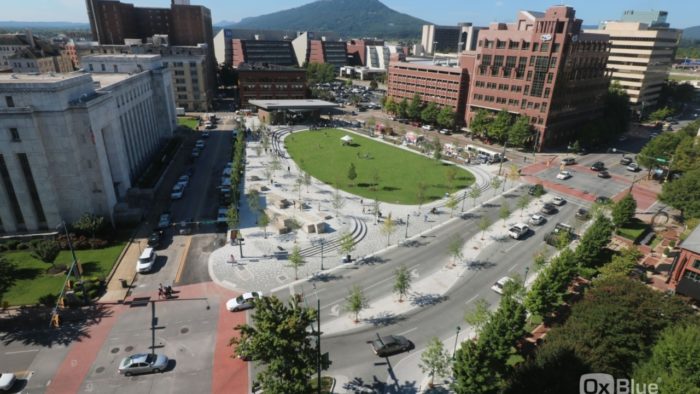
Chattanooga Incline Railway
Chattanooga, Tennessee’s most well-known transit infrastructure may be the Chattanooga Choo-Choo, a former train station made famous by a 1941 swing tune by Glenn Miller and His Orchestra, or perhaps the Lookout Mountain Incline Railway, a tourist-oriented funicular currently owned and operated by the Chattanooga Area Regional Transportation Authority (CARTA). Most days though, Chattanooga’s transit line with the highest ridership is the Route 4 bus from downtown to the eastern suburbs. Although Chattanooga was an early adopter of electric buses, starting their downtown electric shuttles in 1992, transit has not been at the forefront of its planning policies in the past few decades. Like many other similarly sized cities without urban growth boundaries in the US, development has sprawled outwards, enabled by highways, resulting in land use patterns that are difficult to serve by transit.
That is changing. In recent years, Chattanooga has focused efforts on rekindling the inner city, adding housing, retail, and office space downtown, and becoming the first midsize city in the US to designate an urban innovation district. As a recognition of their efforts to build vibrant public spaces, Chattanooga will be hosting the Project for Public Spaces placemaking conference this Fall, the third city to do so after Amsterdam and Vancouver. But in order for a city center integrated within a growing regional economy to scale up without being choked by traffic congestion, Chattanooga needs better transit. Today, the city is starting to reconsider the role of the bus and may be ready to make major changes to its bus services and perhaps invest more in it.

The recently revamped Miller Park in Downtown Chattanooga. Photo: downtownchattanooga.org
We’ve been studying the transit system in Chattanooga for over a year and in June CARTA released our report outlining four possible concepts of what the future of transit could look like. These four concepts show a range of options between coverage and ridership goals with no new funding and two options with additional funding for transit. Happily, the local newspaper’s coverage is clear and accurate.
The release of this report begins the period of public discussions and surveys. The results of that discussion will inform the decision that the CARTA Board makes in August about what direction the final plan should take.
Our report discusses four possible futures but most likely, the final plan won’t look quite like any of these. The key idea — as in much of our work — is to open up a “decision space” in which people can figure out where they want to come down on the two difficult policy decisions:
- Ridership vs coverage? What percentage of resources should to go pursuing a goal of maximum ridership — which will tend to generate frequent service in the densest urban markets — as opposed to the goal of coverage — spreading service out so that as many people as possible have some service nearby?
- Level of investment in service? How much should the community invest in service? The more it invests the more it gets in value, but the value it gets depends in part on how you answer the ridership-coverage trade-off.
If you live in Chattanooga or know anyone there, now is the time to get involved. Download the report, read at least the executive summary, form your own view, and share it with us here! The more people respond, the more confident we’ll be in defining the final plan based on their guidance.